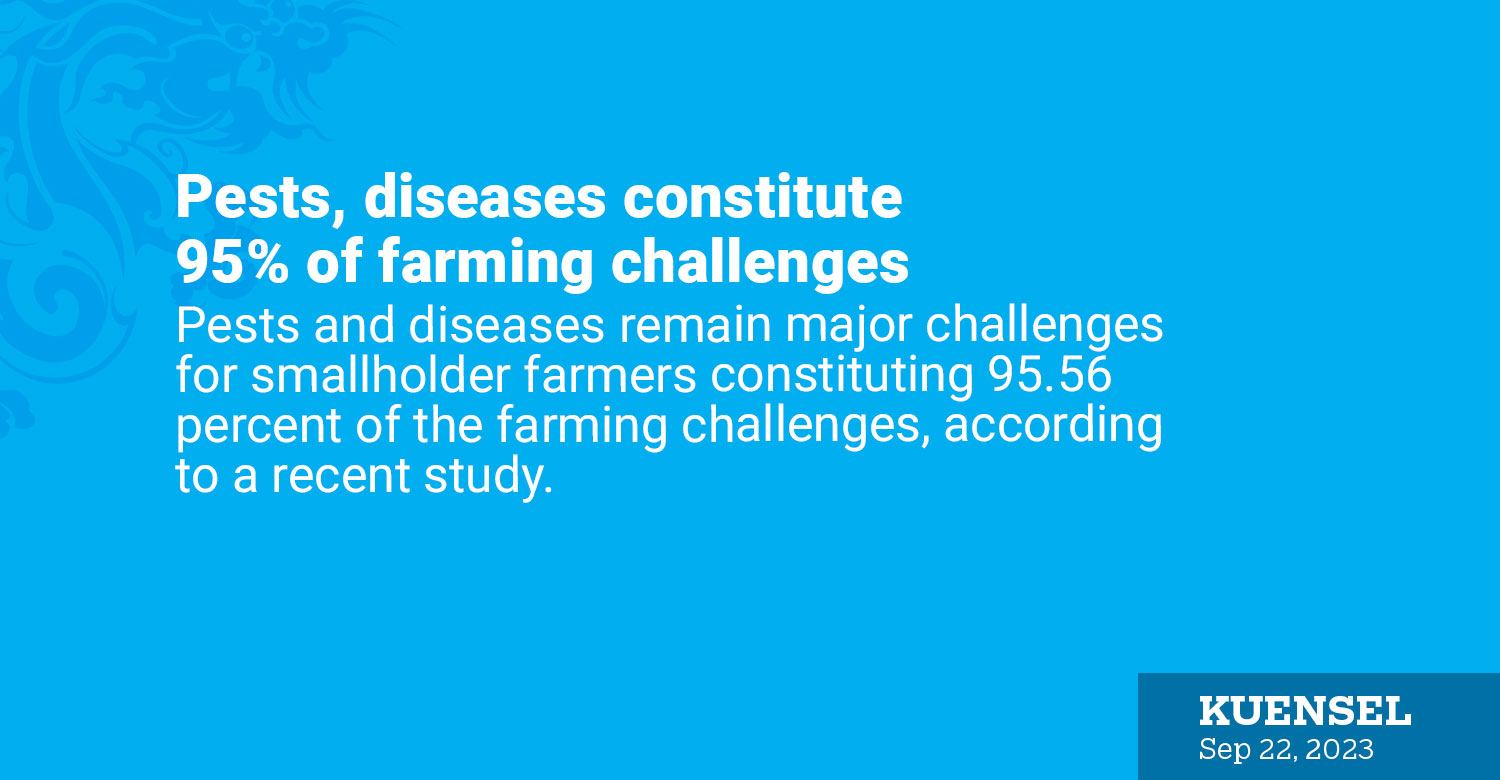
… farmers lack adequate climate-smart agriculture practices
Pests and diseases remain major challenges for smallholder farmers constituting 95.56 percent of the farming challenges, according to a recent study.
The study, “Smallholder farming and climate-smart agriculture,” in Pemagatshel, states that agriculture is no more the backbone of the Bhutanese economy although it employs 62.1 percent of the working population in rural areas. Last year, it contributed only 14.67 percent to the economy.
Four lecturers from the College of Natural Resources and a Professor from W.A Franke College of Forestry and Conservation conducted the study in 2022.
The study found farmers had five major challenges: plant protection for pest and diseases, followed by wild animal damages up to 93.95 percent, farm labour shortage of 54.84 percent, irrigation issues of 47.58 percent and post-harvest losses of 45.16 percent.
Bhutanese farmers practise a subsistence-integrated farming system where they grow a variety of crops along with a few domestic animals, the researchers said.
The study reveals that new pests and diseases have caused major losses to the food crops in the dzongkhag. The study was conducted in Chhimoong, Chongshing and Yurung gewogs of Pemagatshel.
Human-wildlife conflict like elsewhere in the country—porcupines, deer, wild boars and monkeys were major destroyers. The farmers reported that they use scarecrows, stones or wooden fences and guard the fields. These methods were seen as ineffective.
The farmers also use the electric fencing provided by the government. Farmers’ poor management of electric fencing and cooperation among the farmers has compromised its effectiveness in controlling wild animals. Nation-wide, the chain-linked fencing is expected to reach 6,484km this year.
The report also highlights that agriculture in Bhutan is still labour-intensive—the shortage of labour in the field has made it challenging for mass production and cost. The cost of labour across the country has reached in between Ngultrum 400 and 1500 per day.
Bhutan has 70,576 cubic hectometres of freshwater. Yet, only 1 percent is used. The farmers witnessed drying water sources for irrigation.
This was closely followed by post-harvest issues of loss during the seed storage.
The report highlights that climate change threatens agricultural production and food security in Bhutan.
Climate-smart agriculture was found as one of the measures of adaptation towards climate change—yet Bhutanese farmers lacked adequate knowledge on CSA, attributed to the unavailability of training and support on it.
Although every gewog has an agricultural extension official, the government has made limited strides towards designing CSA technologies and capacity development programmes suiting Bhutan’s agro-climate, topography, and small-scale farmers.
On a gender basis, 66,075 women are employed in the agricultural sector compared to 59,136 men. The gainful yield wasn’t shown. The reason was attributed to less women-friendly farm machinery and tools.
The gewogs have abandoned wetland paddy cultivation. This implies the same in major portions of the country with increasing fallow lands and gungtongs.
Associate Professor, CNR, Dr Sonam Tashi said that food security issues cannot be achieved without addressing the impacts of climate change—the varying climate has reduced crop production. “The farmers with training on climate-smart agriculture is minimal in the country.”
“More pest outbreaks involving a greater range of insect pests are projected in future. Insects are anticipated to broaden their geographic range as a result of climate change,” he said. As a result, there will be an increase in insect-transmitted plant and livestock diseases as well as invasive pest species.
Another finding of the study was that 93.55 percent of the farming communities have been practising seed-saving as a CSA practice, followed by farmyard manure use (88.31 percent) and mixed cropping strategy up to 77.02 percent.
The country is facing an issue of gungtong. Although more of the active-age population resides in rural areas (65.9 percent) compared to urban areas (34.1 percent)—between 2020 and 2021, the working-age population in rural areas decreased by 0.7 percent compared to 2.2 percent increase in urban areas, according to National Statistics Bureau, 2021.
As per the “Assessment for Climate Risks on Agriculture for NAP formulation,” climate change is having a significant impact on agriculture, as well as agricultural pests and diseases.
The general consequences of climate change on disease and insect dynamics include expansion of geographic range, increased survival rates of overwintering populations, increased risk of introduction of invasive insect species, increased incidence of insect-transmitted plant diseases due to range expansion and rapid reproduction, and increased incidence of insect-transmitted plant diseases due to range expansion and rapid reproduction.
In recent years, Paddy production in Bhutan has been beset with other issues such as the appearance of new diseases and insect pests.
Employment in agriculture decreased by 22 percent in the last five years.
The research was done by researchers from CNR under Partnerships for Enhanced Engagement Research (PEER) programme supported by the United States Agency for International Development (USAID).












